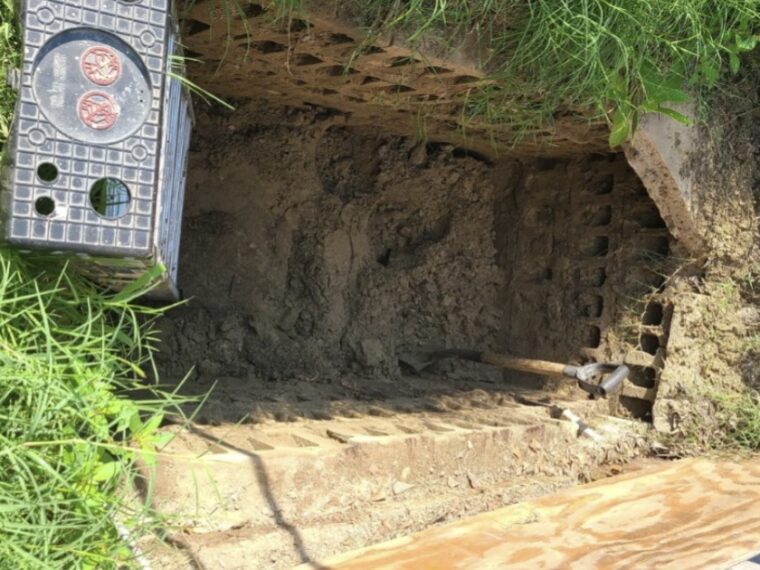It was an ordinary weekend. I planned to sow some marigolds or maybe finally put up that bird bath that had been sitting in the garage for months. The sun was warm, the breeze gentle — the perfect day for yard work. But instead of a peaceful gardening session, I stumbled upon something that completely floored me: a mysterious square hole in the corner of my yard, hinting at a hidden structure beneath the surface.
At first, it didn’t look like much. Just a patch of disturbed earth, an odd depression against the otherwise uniform soil. But curiosity got the better of me. I grabbed a small trowel and started scraping away the dirt. The soil gave way to something solid — concrete slabs wired together with rusty chicken wire. That was strange. Why would there be concrete slabs buried here, and why held together in such a way?
As I cleared away more dirt, the outline of a rectangular pit emerged. It measured about 36 inches wide and 72 inches long, with walls built of concrete blocks stacked in five sturdy courses. The first course was about a foot below ground level. This wasn’t some careless hole or an animal’s den — this was deliberately built.
A Hole That Told a Story
My mind raced. What could this be? At first, I thought it might be an old outhouse pit, but it was too big and too precisely built. The craftsmanship was clear. Whoever had constructed this had a purpose and had taken time to do it right.
That’s when memories of my grandmother’s stories flashed through my mind. She grew up on a farm in the early 1900s, before indoor plumbing was common. They relied on rain barrels, wells dug by hand, and improvised water storage. Suddenly, standing over this pit, everything clicked. This had to be a hidden cistern — a water storage tank built underground to collect and keep rainwater.
What Was It Really?
I started to research the possibilities. It could have been:
- A Cistern or Water Storage Tank: In times before reliable plumbing, people needed ways to collect and store water. Rainwater was precious, especially if wells ran dry or the water was difficult to access. The size and depth of the pit matched common cistern dimensions. The concrete and chicken wire construction suggested a structure built to hold water safely.
- A Septic Tank: Possible, but septic tanks tended to be more utilitarian, often buried deeper and without such a neat concrete surface.
- A Root Cellar or Storage Pit: These were often used for food storage, keeping vegetables cool through the year. However, root cellars tended to be larger, deeper, and had more ventilation openings.
- A Dry Well: Used for drainage, dry wells were designed to let water seep into the ground rather than hold it. The construction I uncovered suggested containment, not drainage.
All signs pointed toward a cistern, an artifact of a time when water was a precious resource and ingenuity was required to capture it.
A Glimpse Into the Past
My house was built in the early 1900s, a period when modern plumbing wasn’t a given. People had to work around the absence of running water. They dug wells, collected rainwater, stored it carefully, and made every drop count.
Standing there, looking down into that pit, I felt a connection to the past — to the lives that preceded mine on this same patch of earth. No luxuries, no frills, just function and necessity. The entire property was part of a carefully balanced system of living.
I imagined a family, maybe a mother collecting rainwater in barrels, children fetching water from the cistern, the entire household working together to make life manageable with limited resources.
The Pit Meant Something
This hole was more than just a buried relic. It was a tangible reminder that someone once depended on it to survive. It held water, yes, but it also held effort, intention, and care. Every concrete block set into place was a testament to that effort.
We so often forget that our homes are layered with stories — that beneath the modern convenience of faucets and pipes lies a history of struggle and innovation.
The cistern wasn’t built to impress anyone; it was built to live.
When You Dig, You Might Find More Than Dirt
The next time you’re digging in your garden, or renovating an old house, you might come across a root, a rock, or maybe something unexpected. It could be a hidden cellar, a forgotten well, a marker of what came before.
If you do, take a moment. Don’t just sweep it aside. Ask questions. What was this? Why was it there? Who depended on it?
These small discoveries remind us that every place has a history, often buried just beneath the surface.
Preserving History, Embracing Stories
Unearthing the cistern made me realize the importance of preserving such finds. In a world rushing toward new technologies and instant gratification, these old structures ground us.
They are proof of human resilience, creativity, and the ability to adapt to challenges. They remind us that life wasn’t always easy, and that every convenience we enjoy today was hard-won.
They also offer lessons — about conservation, resourcefulness, and community.
Connecting to Generations Past
It’s humbling to hold a piece of history in your hands, even if it’s a section of concrete blocks and wire beneath your feet. It ties us to the generations who came before us, whose hands shaped the land, whose lives laid the foundation for ours.
That connection to the past adds depth to the meaning of home. It’s not just where we live; it’s where history lives, too.
The Emotional Impact of a Simple Hole
Oddly, that hole stirred emotions in me I didn’t expect. I thought about the lives that revolved around that cistern — the hardships, the joys, the everyday struggles.
It reminded me of the strength in simplicity, the quiet heroism of those who made do with what they had.
I found myself grateful — for the advances in technology, yes, but also for that enduring human spirit that built those old homes and water systems with care and determination.
What This Taught Me About Modern Living
Finding the cistern gave me a fresh perspective on modern comforts. Running water at the turn of a tap seems ordinary now, but it’s a luxury built on decades of innovation and countless acts of human perseverance.
It’s easy to take things for granted.
This discovery encouraged me to be more mindful — to appreciate the conveniences, but also to recognize the value of conservation and respect for resources.
Sharing the Story
I shared my find with neighbors and local historians. The response was incredible. Many had stories of their own — relatives who lived without plumbing, tales of rainwater harvesters and well diggers.
It sparked conversations about the neighborhood’s history and inspired community efforts to document and preserve these hidden histories.
It turns out my backyard pit wasn’t just a personal discovery; it was a doorway to collective memory.
What to Do If You Find Something Similar
If you uncover a structure like this in your yard:
- Document It: Take photos, measurements, and notes about location and construction.
- Research: Check property records, local history archives, or talk to longtime residents.
- Preserve: Avoid damaging the structure. Consult with historians or archaeologists if possible.
- Share: Stories and history are meant to be shared. It enriches the community’s sense of identity.
The Hidden History Beneath Our Feet
Our backyards and properties are not just patches of earth; they are archives of human life, endurance, and creativity. The cistern I found is just one example of countless stories buried beneath the surface, waiting to be rediscovered.
Every old home has secrets — be it a hidden cistern, a forgotten well, an old root cellar, or even a simple boundary marker.
Finding these relics connects us to the past in a way no textbook or museum display can match.
Final Thoughts: More Than Just a Construction Puzzle
That tiny pit in my yard left me with more than a mystery solved. It gave me perspective on the lives lived here before me. It showed me the tangible traces of human adaptation and care.
Most importantly, it reminded me to slow down, look deeper, and appreciate the layers of history hidden just beneath our feet.
And that — that is truly a rare and valuable find.





